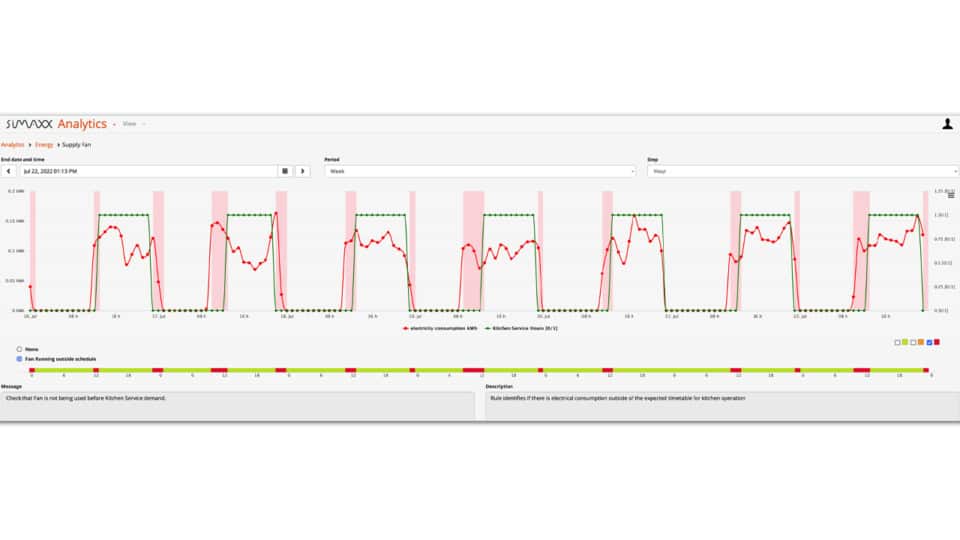Air quality monitoring
Air quality can be a serious concern for many property and business owners. Even if you can identify situations where poor air quality is causing problems, it is not always easy to respond to that information well, especially not if you are unprepared.
Breathe in. Breathe out.
The best way to ensure that air pollution poses no threat is to keep monitoring the air in your property. Good air quality monitoring techniques can allow you to track current levels and concentrations of air pollution, as well as provide you with more detailed information on how to improve your site’s air quality going forward.
Step 1
Site BMS or IoT sensor integration
Air quality and IAQ sensor systems can be imported from a site Building Management System or by using an IoT wireless solution and gateway. These provide valuable insights into key air quality parameters: particulate matter (PM), volatile organic compounds (VOCs), carbon dioxide (CO2), and other relevant indicators
Step 2
Real-time monitoring
Tyrrell Analytics platform continuously monitor air quality in real-time, providing up-to-the-hour data on pollutant levels and environmental conditions
Step 3
Alerts & notifications
The system generates alerts or notifications if air quality parameters surpass predefined thresholds, enabling prompt responses to maintain a healthy indoor environment
Step 4
Visualisation dashboards
Building managers and tenants can access easy-to-understand dashboards that visually represent current air quality conditions. This facilitates quick assessments of IAQ status
Step 6
Historical data analysis
Historical data allows users to analyse trends in air quality over time and identify patterns or recurring issues
Health & productivity impact
By monitoring air quality, the platform contributes to maintaining a healthy indoor environment, reducing the risk of respiratory issues and other health concerns associated with poor air quality. Studies have shown that improved air quality can enhance cognitive performance and productivity, making air quality monitoring a valuable tool for optimising workplace environments.
Automatic monitoring
Automatic monitoring offer more effective ways of gathering information about pollutant levels, allowing you to collect data every hour without needing to actively monitor the situation.

Estimation & prediction
By shifting all of IAQ data into one central location, it becomes much easier to analyse everything you have monitored, using that information to build forecasts and find likely causes of particulate matter pollution.
Simaxx provides an easy way to gather information and predict long-term trends for your total air pollution levels, letting you estimate future control effectiveness based on the emissions you have already produced.
While it is still best to use hard data whenever possible, looking into long-term trends and personal predictions for your pollutant levels is important. Pollution forecasts can provide valuable insight into your long-term air quality and give you a baseline for how your pollutant levels may increase if left unchecked.

Reporting and analytics
Centralised location for all data
By shifting all of IAQ data into one central location, it becomes much easier to analyse everything you have monitored, using that information to build forecasts and find likely causes of particulate matter pollution.
Customisable reports
Users can generate reports summarising air quality metrics and trends, which can be useful for internal assessments and communication with stakeholders.
Historic data
Having easy access to so much historical data allows you to achieve full monitoring of your energy performance. You can use your entire energy efficiency history to form baselines and figure out expected results, using any point of data you need without the worry of it being lost or corrupted.

Compliance
Regulatory compliance
The system can assist building managers in adhering to indoor air quality regulations and standards by providing data for compliance reporting.

Integration with Smart Building ecosystems
Synergy with other systems
Air quality monitoring services are often part of a broader smart building ecosystem, integrating with other systems such as lighting, security, and energy management for holistic building optimisation.

Solution
Tyrrell Analytics air quality monitoring solution leverage sensor technology and data analytics to ensure that indoor environments are healthy, comfortable, and conducive to productivity. Solution plays a vital role in creating intelligent and responsive building ecosystems that prioritise the well-being of occupants.
